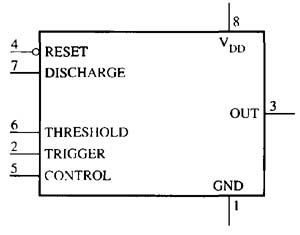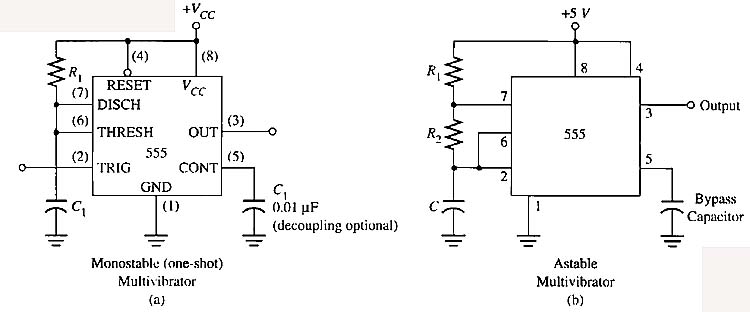Timers are used in a variety of applications in industrial electronic circuit boards and as stand-alone timers. This section will explain the simple one-shot timers and 555 timers, and the next section will explain stand-alone timers. The one-shot timer is a simple timer that can be made by modifying the basic edge-triggered flip-flop.
One-Shot Timers
Fig. 20a shows the logic symbol for a one-shot timer, arid Fig. 20b shows a one- shot timer circuit with an external resistor and capacitor. The one-shot timer is useful because it will take an input pulse of any duration and provide one output (pulse) that lasts for a predefined time. This means a limit switch could provide the input and it could stay closed for 2 seconds, and the one-shot timer could produce an output pulse of 2 milliseconds (0.002 seconds). The amount of time the pulse stays on can be adjusted by changing the values of the resistor and capacitor that are connected to the external terminals of the flip-flop.
The one-shot timer is called a monostable multivibrator, since it has a single stable state. When a trigger pulse is applied to the input of the flip-flop, the capacitor begins to charge. The rate of charge is controlled by the size of the resistor. When the voltage charge on the capacitor reaches the proper amount, it will cause the flip-flop to transition and produce an output. The formula for setting the output pulse width, t(w), is determined by the values of the external resistor, R(EXT), and external capacitor, C(EXT). The following formula shows the relationship for the resistor and capacitor.
t(w)=0.7 R(EXT) (EXT)
R(EXT)= t(w)/ 0.7 C(EXT)
or:
C(EXT)= )= t(w)/ 0.7 R(EXT)

Above: Fig. 20: (a) The logic symbol for a one-shot timer. (b) A one-shot timer with an external resistor and capacitor.
The one-shot timer is available as a non-retriggerable device or as a retriggerable device. The retriggerable device has a clear input that can be used to retrigger the one-shot timer. The one-shot pulses have a variety of applications for industrial systems. The most usable application is to take the unpredictable operation of the contacts of a field device, such as a limit switch or other switch, and provide a predictable and reliable timed pulse.
The 555 Timer
The 555 timer is widely used in industrial circuits. Fig. 21 shows the block diagram of a 555 timer. The inputs include threshold, trigger, control voltage, discharge, and reset. External capacitors and resistors are used to con figure the timer as a mono- stable multivibrator, which can produce a one-shot output, or as an astable multivi brator, which will produce a train of pulses as an oscillator. Fig. 22a shows a 555 timer as a monostable multivibrator (oscillator) and Fig. 22b shows a 555 timer as an astable multivibrator (oscillator).

Above: Fig. 21: Block diagram of a 555 timer.

Above: Fig. 22: (a) Diagram of the 555 connected as a monostable (one-shot) device. (b) Diagram of the 555 connected as an astable oscillator.
When the 555 is connected in the monostable (one-shot) mode, it has an external resistor that is connected between V and the discharge and threshold terminals. The external capacitor is connected in series with this resistor and ground. This sets up the RC time constant for the input. When the 555 is connected as an astable oscillator, the input sees a waveform that is set by the charging and discharging of the C capacitor. Since the capacitor will continue to charge and discharge as long as an input voltage signal is applied, the output will also continue to provide a square wave (on/off) output waveform. The duration of the on and off cycles of the square wave output is determined by the size of the external resistors and capacitors. The 555 is used in a variety of industrial timers to provide the clock pulse or time base for the clock because the output is well regulated.

